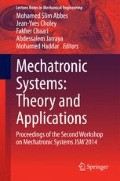Abstract
Characterizing frictional behavior of viscoelastic joints is investigated in the present work. A new visco-tribological model was developed by coupling the rheological Generalized Maxwell model (GMM) and Dahl friction model. Parameters of the proposed model are identified from Dynamic Mechanical Analysis (DMA) tests for different excitation frequencies. Comparison between measurements and simulations of hysteretic friction of the viscoelastic component has been carried on.
Access this chapter
Tax calculation will be finalised at checkout
Purchases are for personal use only
References
Al Majid A, Dufour R (2004) Harmonic response of a structure mounted on an isolator modelled with a hysteretic operator: experiments and prediction. J Sound Vib 277(1–2):391–403
Armstrong-Hétlouvry B, Dupont P, Canudas de Wit C (1994) A survey of models, analysis tools and compensation methods for the control of machines with friction. Automatica 30(7):1083–1138
Awrejcewicz J, Lamarque CH (2003) Bifurcation and chaos in nonsmooth mechanical systems. World Sci Publ, Singapore
Barbosa F, Farage M (2008) A finite element model for sandwich viscoelastic beams: experimental and numerical assessment. J Sound Vib 317(1–2):91–111
Canudas de Wit C, Olsson H, Åström KJ, Lischinsky P (1995) A new model for control systems with friction. IEEE Trans Autom Control AC 40:419–425
Caputo M, Mainardi F (1971) Linear models of dissipation in anelastic solids. In: Society IP (ed) La Rivista del Nuovo Cimento (1971–1977), vol 1. Italian Physical Society, pp 161–198
Castello D, Rochinha F, Roitman N, Magluta C (2008) Constitutive parameter estimation of a viscoelastic model with internal variables. Mech Syst Sig Process 22(8):1840–1857
Chen T (2000) Determining a prony series for a viscoelastic material from time varying strain data, Technical report, NASA
Chevalier Y (2002) Essais dynamiques sur composites. caractérisation aux basses fréquences, Technical report, Techniques de l’ingénieur
Chevalier Y, Vinh JT (2010) Mechanics of viscoelastic materials and wave dispersion, vol 1. ISTE and John Wiley & Sons, Hoboken
Chevallier G (2005) Etude des vibrations de broutement provoquées par le frottement sec—application aux systèmes d’embrayage, Ph.D. thesis P6—LISMMA SUPMECA
Dahl PR (1968) A solid friction model, The Aerospace Corporation, El-Segundo, TOR-158(3107-18), California
Dion JL (1995) Modélisation et identification du comportement dynamique de liaisons hydro-élastiques, Ph.D. thesis, ISMCM, Saint-Ouen
Eborn J, Olsson M (1995) Modelling and simulation of an industrial control loop with friction. In: Proceedings of the 4th IEEE conference on control applications, Albany, New York, pp 316–322
Gaul L, Klein P, Kemple S (1991) Damping description involving fractional operators. Mech Syst Sig Process 5(2):81–88
Haessig DA Jr, Friedland B (1991) On the modeling and simulation of friction. J Dyn Syst Meas Control 113:354–362
Huynh A, Argoul P, Point N, Dion JL, (2002) Rheological models using fractional derivatives for linear viscoelastic materials: application to identification of the behavior of elastomers. In: 13th symposium noise, shock and vibration, Lyon
Karnopp D (1985) Computer simulation of slip-stick friction in mechanical dynamic systems. J Dyn Sys Meas Contr 107(1):100–103
Koeller RC (1984) Applications of fractional calculus to the theory of viscoelasticity. J Appl Mech 51(2):299–307
Long AHK (2005) Analysis of the dynamic behavior of an elastomer: modeling and identification, Ph.D. thesis, LISMMA, SUPMECA, Paris
Moreau A (2007) Identification of viscoelastic properties of polymeric materials by field measurements of frequency response of structures, Ph.D. thesis, LMR, INSA, Rouen
Oberst H, Frankenfeld K (1952) Damping of the bending vibrations of thin laminated metal beams connected through adherent layer. Acustica 2:181–194
Oustaloup A (1991) La commande CRONE: commande robuste d’ordre non entier, Hermés
Park SW (2001) Analytical modeling of viscoelastic dampers for structural and vibration control. Int J Solids Struct 38:8065–8092
Renaud F, Dion JL, Chevallier G, Tawfiq I, Lemaire R (2011) A new identification method of viscoelastic behavior: application to the generalized Maxwell model. Mech Syst Sig Process 25(3):991–1010
Saad P (2003) Nonlinear behavior of rubber bush, modeling and identification, Ph.D. thesis, LTDS, Ecole Centrale De Lyon, Lyon
Soula M, Chevalier Y (1998) The fractional derivative rheological polymers—application to elastic and viscoelastic behaviors linear and nonlinear elastomers. ESAIM Proc Fract Differ Syst 5:193–204
Stribeck R (1902) Die Wesentlichen Eigenschaften der Gleit—und Rollenlager—the key qualities of sliding and roller bearings, Zeitschrift des Vereines Seutscher Ingenieure, 46, 38, pp 1342–48, 46, 39, 1432–1437
Author information
Authors and Affiliations
Corresponding author
Editor information
Editors and Affiliations
Rights and permissions
Copyright information
© 2014 Springer International Publishing Switzerland
About this paper
Cite this paper
Jrad, H., Dion, J.L., Renaud, F., Tawfiq, I., Haddar, M. (2014). Dynamic Characterization of Viscoelastic Components. In: Abbes, M., Choley, JY., Chaari, F., Jarraya, A., Haddar, M. (eds) Mechatronic Systems: Theory and Applications. Lecture Notes in Mechanical Engineering. Springer, Cham. https://doi.org/10.1007/978-3-319-07170-1_15
Download citation
DOI: https://doi.org/10.1007/978-3-319-07170-1_15
Published:
Publisher Name: Springer, Cham
Print ISBN: 978-3-319-07169-5
Online ISBN: 978-3-319-07170-1
eBook Packages: EngineeringEngineering (R0)

